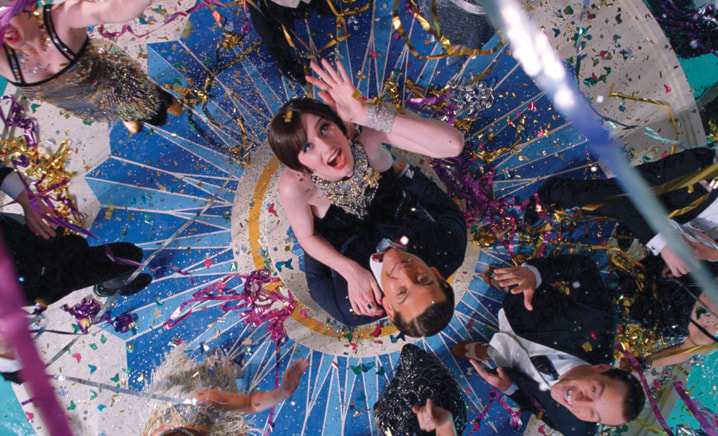The Great Gatsby
Two stars (out of four)
Rated: PG
Baz Luhrmann’s 3D movie camera swoops and dives through the lavish party scenes of The Great Gatsby, so much so you wonder how he resisted adding the exclamation mark he employed for Moulin Rouge!
The Aussie director and showman is in his element whenever the lens turns towards opulence, which this production provides by the golden bucketload: jewelry by Tiffany, clothes by Prada, Miu Miu and Brooks Brothers, cars by Rolls-Royce and Duesenberg, anachronistic hip-hop curated by Jay-Z.
And vertigo by Luhrmann, we might add (and warn). He never tires of the crane shot, gazing down on the Jazz Age decadence of flappers, financiers and finaglers like a hungry seagull looking for an oyster to grab — and let’s hope it’s not just an empty shell.
In this he is of like mind with Jay Gatsby (Leonardo DiCaprio), the title anti-hero of F. Scott Fitzgerald’s classic American novel of 1925. The corn-fed Gatsby is equally restless, described in the book by his friend and enabler Nick Carraway (Tobey Maguire) as “never quite still; there was always a tapping foot somewhere or the impatient opening and closing of a hand.”
DiCaprio is the right man to play Gatsby, possessing the same earnest desire to please and determination to succeed as Fitzgerald’s celebrated striver. It’s a marvel to behold him — lit from behind with exploding fireworks in one of many great party moments — and to see how much he’s matured since the youthful frolics of Romeo and Juliet, his 1996 breakthrough role and first film with Luhrmann.
Leonardo now has a few lines on his face, a few extra pounds on his frame and a glint in his eye that hints at guilty pleasures and secrets. It’s a vast improvement on Robert Redford’s mostly vacant look in the role, in the 1974 production that until now was the most celebrated attempt to adapt Fitzgerald’s deceptively simple book to the big screen.
Gatsby is described as a mystery by his perpetual party guests — is he war hero, mobster, spy or murderer? — but in truth he’s as plain as his bone-white attire and as obvious as his ostentatious Long Island mansion.
The nouveau riche Gatsby, formerly of North Dakota, throws his parties not for personal amusement but in the hope of enticing an appearance by Daisy Buchanan (Carey Mulligan), his lost love. While he was busy fighting the First World War and later making his millions, five long years before this summer of 1922, Daisy was marrying Tom Buchanan (Joel Edgerton), a wealthy thug who boldly carries on an affair with blowsy hotsie Myrtle Wilson (Isla Fisher), reluctant wife of auto mechanic George (Jason Clarke).
Daisy and Tom reside in East Egg, an old-money preserve across the bay from Gatsby’s newly affluent West Egg (both locales are fictional). From his dock, Gatsby can see the green dock light of Daisy’s mansion, a signal that both beckons and warns. He forlornly looks out across the water each night, dreaming of what might have been — and what he still hopes will be.
The connective link between these self-absorbed people is Nick, a modest writer and aspiring financier whose cheap summer cottage rental places him right next door to Gatsby’s palace. Nick is Daisy’s second cousin, and he went to Yale with Tom.
Nick also serves as the story’s narrator, and Luhrmann’s sole major textual change (with co-writer Craig Pearce) has Nick as a recovering alcoholic, making a therapeutic confession to a sanitarium shrink.
When the excitable Mr. Gatsby learns of Nick’s ties to Daisy, he conspires a flower-strewn luncheon rendezvous with Nick’s cottage as the literal halfway house. The game is on, as they say, but if hypocritical Tom finds out what’s going on, the jig will be up.
The story has ample drama to chew upon, and Fitzgerald did so in remarkably few pages — The Great Gatsby is more novella than novel. Yet it’s here where Luhrmann suddenly loses his nerve.
Having done so well with the look of the picture — which is also due in large part to Luhrmann’s wife and collaborator Catherine Martin, the film’s production designer and costumer — he settles for merely filming the book rather than illuminating it.
He pairs his inspired male lead with an uninspiring female one. Mulligan’s Daisy is “a beautiful little fool,” to use the famous Fitzgerald phrase, and she has as much substance as the windblown white curtains that wrap around her at first glimpse. This isn’t entirely Mulligan’s fault, since Daisy is intended to be a figure more of male fantasy than female reality, and the character hasn’t aged well over decades of gender-equity recalibrating.
Precious little screen time is allotted the only two flesh-and-blood women in the film: feisty Myrtle and fast-quipping Jordan Baker, a golf pro played by Aussie actress Elizabeth Debicki, whom we’ll hopefully see more of in the future.
Luhrmann almost gets away with the conjurer’s trick that is his The Great Gatsby, because the film looks so damned good, even though the 3D adds nothing of substance. It will play very well in Cannes next week, when the film opens the annual festival of glamour and cinephilia.
But then we get the climactic scene in a New York Hotel room, when Gatsby and Tom are having their gloves-off “row,” and we get a flash of the real fire that resides inside DiCaprio.
We’re also reminded of what this movie could have been, had not Luhrmann hit the autopilot switch and allowed Fitzgerald to do all the dramatic thinking for him.
And maybe that’s Fitzgerald’s grandest achievement of all: writing a book that continues to fascinate while denying total access, like Daisy’s mystical green light across the bay.
Peter Howell is a syndicated Toronto Star movie critic.
